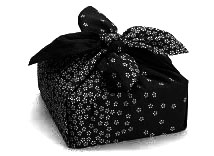Simple Sustainability: Simple gift-giving
by Sky Trombly –
Want. Need. Wear. Read.
‘Tis the season. For buying too much stuff. Gigantic hauls under Christmas and Yule trees, gifts exchanged beside candelabras, gifts that represent consumption mania, environmental devastation, guilt trips, debt, and disappointment. Kids running out of steam before the present pile has been tackled.
Our gift-giving mantra for the kids has become: “Something they want, something they need, something to wear, and something to read.” That totals up as four gifts for each of them.
The reasons we do this are many.
Firstly, it puts a cap on gifts; once we reach a certain number, we know we can end our shopping spree instead of continuously shopping from October through December. After we have acquired the items we can relax.
It also de-emphasizes gifts, making them a part of the holiday season and not the center of it. It’s really hard to ignore a gigantic pile of wrapped mystery in the family room. Instead of focusing on wrapped things, we’ve made family activities our priority.
Obviously, getting fewer presents will save us money. We’ve chosen to budget by putting a spending cap on the total amount as well as a cap for each category.
Acquiring fewer items serves our minimalist goals – we’re not cluttering up our homes as much.
By categorizing our consumption by “wants”, “needs”, “wears” and “reads”, we gain insight into the role each gift is taking in our lives. A pair of snow boots, for example, fulfills a need in our winter climate and allows our kids to see the value in getting a need met (hopefully!).
For inspiration purposes, this is what I mean by each category:
“Wants” = Games, toys, art and craft supplies, movies, hobby supplies, etc.
“Needs” = Functional clothes, bedding, winter gear, sport or club supplies, school supplies, etc.
“Wears” = Clothes for fun (such as a t-shirt with a favorite character on it), jewelry, hats, ceremonial, hand-made, etc.
“Reads” = Books, educational games/toys, magazine subscriptions, etc.
 Furoshiki: The Japanese Art of Wrapping in Cloth
Furoshiki: The Japanese Art of Wrapping in Cloth
My main interest in simplifying my family’s gift-giving habits is environmental. I’ve always mourned the the heaps of wrapping paper discarded at the holidays.
This year, I discovered the Japanese art of wrapping in cloth, called furoshiki, and rejoiced. Since there are fewer presents overall, I have decided to wrap them in re-usable cloth. I already own festive cloth and decided to create a stock of square pieces in varying sizes. We should be able to use these year after year.
Furoshiki is typically done with square cloths between 18 inches and 28 inches wide. The size needed depends on the size of the gift, but a good stock size is 28 inches. There are many tutorials available over the internet for those wishing to embrace this art form.
Limiting Extra Gift-Giving Burdens
One of the most stressful things about the holiday time is the gift-giving game. This is the worry over social niceties and predicting who will give to you and what is required in return.
This spending to save face can lead to unwanted debt. And receiving can lead to unwanted clutter. Backing out of this game is not always possible, but we do try.
Sometimes explaining to friends and family that we’ve decided to simplify and would prefer not to receive gifts is enough. Sometimes we ask for money or experiences en lieu of gifts, but this then obligates us to give something in return. This in itself can be stressful.
We’ve chosen to only give cards to our elderly family members (or those less digitally-minded). We include a few photos. We’ve chosen e-cards for our younger friends and family and include digital photos. We generally do not buy gifts for friends or family who aren’t visiting us during the holidays.
If we know someone will be here, we buy them a gift. We also make fudge batches to give as a pleasant, short order, and nearly universal gift for surprise visitors and gift-givers.
My Wish for You
I hope that this guide serves you this upcoming holiday season. I hope it brings more clarity and peace and less stress.